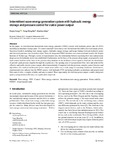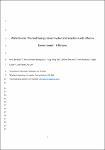Intermittent wave energy generation system with hydraulic energy storage and pressure control for stable power output
| dc.contributor.author | ruiyin, song | |
| dc.contributor.author | Dai, Yong Ming | |
| dc.contributor.author | Qian, X | |
| dc.date.accessioned | 2018-09-18T17:31:41Z | |
| dc.date.available | 2018-09-18T17:31:41Z | |
| dc.date.issued | 2018-12 | |
| dc.identifier.issn | 0948-4280 | |
| dc.identifier.issn | 1437-8213 | |
| dc.identifier.uri | http://hdl.handle.net/10026.1/12378 | |
| dc.description.abstract |
In this paper, we introduced an intermittent wave energy generator (IWEG) system with hydraulic power take-off (PTO) including accumulator storage parts. To convert unsteady wave energy into intermittent but stable electrical output power, theoretical models, including wave energy capture, hydraulic energy storage, and torque balance between hydraulic motor and electrical generator, have been developed. Then, the integrated IWEG simulator was constructed and tested at the Ningbo Institute of Technology. Through a series of experimental tests, the relationship between operating flow rates and pressure drops across the hydraulic motor was established. Furthermore, on the basis of the pressure drop signal, we proposed a feedback control method on the basis of the pressure drop database as the feedback control signal to eliminate the disturbance of periodic peak pressure impulse through the regulation of the opening ratio of a proportional flow valve and achieved the effective and stable electric power output, albeit intermittently. Compared with the previous complex control theories and algorithms, this method can keep the power output more stable over a wide range of operating conditions. Furthermore, experimental tests indicate that the IWEG system, with hydraulic PTO, including hydraulic accumulator and proportional flow control valve, is simple, reliable, and easy to control. Most importantly, the real-time power output is stable, and power quality and generation efficiency are significantly improved. | |
| dc.format.extent | 802-813 | |
| dc.language | en | |
| dc.language.iso | en | |
| dc.publisher | Springer Science and Business Media LLC | |
| dc.subject | Wave energy | |
| dc.subject | PTO | |
| dc.subject | Control | |
| dc.subject | Wave energy converter | |
| dc.subject | Intermittent wave energy generation | |
| dc.subject | Power stability | |
| dc.subject | PDDFC | |
| dc.subject | Experimental study | |
| dc.title | Intermittent wave energy generation system with hydraulic energy storage and pressure control for stable power output | |
| dc.type | journal-article | |
| dc.type | Journal Article | |
| plymouth.author-url | https://www.webofscience.com/api/gateway?GWVersion=2&SrcApp=PARTNER_APP&SrcAuth=LinksAMR&KeyUT=WOS:000451442700006&DestLinkType=FullRecord&DestApp=ALL_WOS&UsrCustomerID=11bb513d99f797142bcfeffcc58ea008 | |
| plymouth.issue | 4 | |
| plymouth.volume | 23 | |
| plymouth.publication-status | Published | |
| plymouth.journal | Journal of Marine Science and Technology | |
| dc.identifier.doi | 10.1007/s00773-017-0512-4 | |
| plymouth.organisational-group | /Plymouth | |
| plymouth.organisational-group | /Plymouth/Faculty of Science and Engineering | |
| plymouth.organisational-group | /Plymouth/Faculty of Science and Engineering/School of Engineering, Computing and Mathematics | |
| plymouth.organisational-group | /Plymouth/PRIMaRE Publications | |
| plymouth.organisational-group | /Plymouth/REF 2021 Researchers by UoA | |
| plymouth.organisational-group | /Plymouth/REF 2021 Researchers by UoA/UoA12 Engineering | |
| plymouth.organisational-group | /Plymouth/Research Groups | |
| plymouth.organisational-group | /Plymouth/Research Groups/Marine Institute | |
| plymouth.organisational-group | /Plymouth/Users by role | |
| plymouth.organisational-group | /Plymouth/Users by role/Academics | |
| dc.identifier.eissn | 1437-8213 | |
| dc.rights.embargoperiod | Not known | |
| rioxxterms.versionofrecord | 10.1007/s00773-017-0512-4 | |
| rioxxterms.licenseref.uri | http://www.rioxx.net/licenses/all-rights-reserved | |
| rioxxterms.type | Journal Article/Review |




